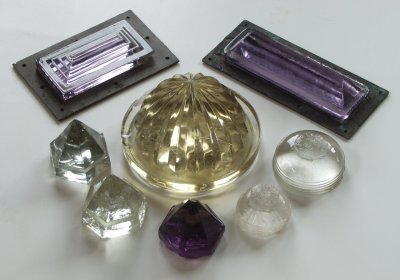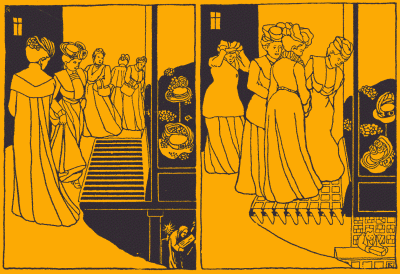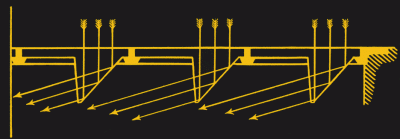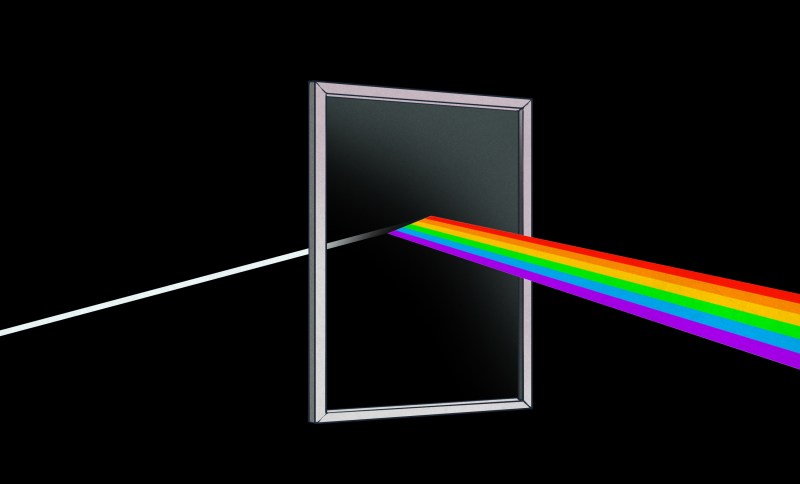The incandescent light bulb was one of the first early applications of electricity, and it’s hard to underestimate its importance. But before the electric light, people didn’t live in darkness — they thought of ways to redirect sunlight to brighten up interior spaces. This was made possible through the understanding of the basic principles of optics and the work of skilled glassmakers who constructed prism tiles, deck prisms, and vault lights. These century-old techniques are still being applied today for the diffusion of LEDs or for increasing the brightness of LCD displays.
Semantics First!
People in optics are a bit sloppy when it comes to the definition of a prism. While many of them are certainly not geometric prisms, Wikipedia defines it as a transparent optical element with flat, polished surfaces of which at least one is angled. As can be seen in the pictures below some of the prisms here do not even stick to this definition. Browsing the catalog of your favorite optics supplier you will find a large variety of prisms used to reflect, invert, rotate, disperse, steer, and collimate light. It is important to point out that we are not so much interested in dispersive prisms that split a beam of white light into its spectrum of colors, although they make great album covers. The important property of prisms in this article is their ability to redirect light through refraction and reflection.
A Safe Way to Bring Light Under Deck

One of the most important uses of prism lighting was on board ships. Open flames could have disastrous consequences aboard a wooden ship, so deck prisms were installed as a means to direct sunlight into the areas below decks. One of the first patents for deck lights “THE GREAT AND DURABLE INCREASE OF LIGHT BY EXTRAORDINARY GLASSES AND LAMPS” was filed by Edward Wyndus as early as 1684. Deck prisms had typical sizes of 10 to 15 centimeters. The flat top was installed flush with the deck and the sunlight was refracted and directed downward from the prism point. Because of the reversibility of light paths (“If I can see you, you can see me”) deck prisms also helped to spot fires under deck.
Making Shopping Easier for the Ladies

In the 19th century, the idea of prism lighting was adapted to vault lights that directed sunlight into sidewalk vaults and basements. Compared to open grates, these not only provided protection from rain but were also easier to walk on. The latter was apparently considered a great advantage for shop owners helping them to bring women closer to their store windows despite their impractical footwear.

In the beginning, vault covers used round plano-convex lenses or even just flat glasses. The prism shape that was used in ship decks was adapted for vault lights only later by Edward Hayward in 1871. His glass prisms not only let light pass through but also redirected it sideways into the room. Hayward’s prisms were based on total internal reflection which occurs when light tries to exit the glass above a critical angle.
From Prism Tiles to Gas Cylinders
Eventually, prism glass was also applied to vertical windows with much commercial success. The biggest player in the game was the Luxfer Prism Company which started to sell prism tiles in 1897 based on an earlier patent by James G. Pennycuick. The 4-inch wide square Luxfer tiles were typically installed above storefront windows.

The inner surface of the tile was covered with horizontal prisms that redirect light deeper into the room than the sunlight would otherwise reach on its own.
Although their commercial success was brought to a halt with the availability of cheap electric lighting, the tiles can still be seen in many small towns in the US. The Luxfer company survived by changing its business to metal products and is now the world’s biggest manufacturer of high-pressure aluminum cylinders for gas storage. Luxfer tiles that often contain ornamental patterns designed by lead architects of the time are now a collector’s item. Frank Lloyd Wright was a high-profile booster.
LED Diffusers and LCD Screens
Although nowadays electricity is cheap and LEDs are super-efficient compared to incandescent lamps, the more efficient use of sunlight for interior lighting is undoubtedly a worthy goal, if not just for the superior color rendition. The modern version of prism tiles are daylight redirecting window films. The thin plastic films include a microstructured saw-tooth pattern that refracts light upwards to the ceiling from where it is reflected and reaches deeper into the building — the thin plastic equivalent of Luxfer tiles. According to 3M the film can save up to 52% on lighting energy costs.

You might already be familiar with prism films in case you were ever looking for ways to diffuse LEDs. Micro prism sheets made from polystyrene or polycarbonate are a common solution to homogenize the light of an LED array. In addition, if you ever tore down an LCD screen you will have noticed several plastic sheets sandwiched underneath the glass. These also contain prism films to enhance the brightness of the backlight screen.
As shown in the picture the prism film will converge light towards the viewer thereby increasing the on-axis brightness while at the same time limiting the viewing angle. Often two of these films are stacked with 90 degrees rotation to converge light in both the horizontal and vertical planes.
These films are also starting to show up in high-end LED lighting applications, and it’s probably only a matter of time, and price, before they become ubiquitous. The incandescent bulb killed the prism, the LED is killing the incandescent, and the prism is getting rediscovered. What’s old is new again!
Prisms are somehow the swiss army knife of optics, a multipurpose tool when it comes to steering light. Even if manufacturing techniques, materials, shapes, and dimensions have changed over the centuries the ability to redirect light through simply shaped transparent bodies still finds a lot of useful applications.
















Great article, I always considered luxfers as just transparent bricks, not a way to redirect light beam
I was really hoping heliostats coupled to fiber optics to pipe light into buildings would take off.
I think you’re right, amazing powers of observation.
The prism concept is still being applied to windows. 3M daylight redirecting film serves the same purpose, directing a portion of the light coming through the window upwards to bounce off the ceiling and further into the room.
https://www.3m.com/3M/en_US/building-window-solutions-us/solutions/daylighting/
I remember seeing a couple years ago that people in areas without electricity would take a clear 20oz bottle, fill it with water and a bit of bleach (to dissuade shit from growing in it and clouding it up) and then mount them through holes in the roof with some resin to bring some light in that way.
https://www.bbc.com/news/magazine-23536914
That is a great article. Thanks for sharing.
https://hackaday.com/2011/03/08/soda-bottle-skylights/ predates the BBC report by a couple of years.
I’ve heard of some public buildings reviving this idea for chandeliers that use sunlight piped in from the roof as well.
IIRC, in Japan ( a couple of decades ago?) they used fiber optics to transfer sunlight from roof collectors (shaped like sunflowers) down into multi-story buildings.
Great article ! I enjoyed the history tie in. It gave me an OMG moment. My hometown of Bloomington, Illinois had the Luxfer tiles in several old buildings which are gone now but there are several locations where the vault prisms are still in the old sidewalks.
Bloomington Illinois. Never an empty table on a Friday night… 💯
+1
It may be the home of State Farm but we refer to the place as “Boring ton/Normal” – where the new motto for the area is – I hated my neighbors…so I moved away from there..”
What was the advantage of a prismatic deck light over just a glass port? I get that a large sheet of glass isn’t practical in a deck and a small glass block is more practical, but what advantage does making your small window prismatic give you?
The advantage is that it redirects the light in more useful directions compared to a simple window.
It’s basically a light diffuser with very low internal losses, so you don’t get just a single sunbeam in the middle of the room and shadows elsewhere.
Inner spaces that don’t have port holes.
Prisms. Just the thing to stick in front of your laptop camera, if you want to shoot video of the keyboard.
I think that’s a mirror
Aziz! Light!
lots of clapping
Encore!
I see a Fifth Element reference (right?) ….all I can say is….Moooltipass…
Multipass?
That’s pretty awesome. I remember seeing such prisms in the Seattle Underground, I believe. Fascinating.
I saw a Discover Channel show about the Vikings using “prisms” of selenite mineral for navigation even during overcast days.
https://pufflesandhoneyadventures.files.wordpress.com/2017/09/vikingsunstone1.jpg
They used them to track the position of the sun, which gives them the time of day and allows them to remain on the same line of latitude. Their navigation was based on sailing up and down the coast and then at a specific point taking off to west to hit England, Iceland, Greenland, etc. and missing those they’d land in Newfoundland – if they survived that far.
They didn’t have any accurate way to navigate in the north-south direction because they couldn’t control their rate of movement, so while they could point the ship at any arbitrary angle relative to the sun, they didn’t know how far they went and going “diagonally” would see them lost at sea.
The real problem in those days was sailing off the edge of the world..😁
Well, the vikings believed that the lands were surrounded by sea and the sea was surrounded by ice to keep the water from falling over the edge.
One thing that could have been mentioned as an aside is that prisms were used to split light into to colors which later were found to have discreet absorption lines (Fraunhofer) which indicate temperature as well as elements present.
SerraLux has Daylight Redirecting Films – both translucent and transparent options
But where can I buy these light redirecting films at a reasonable price?
This!
Additional xref to https://hackaday.com/2018/11/16/supercon-designing-your-own-diffractive-optics/